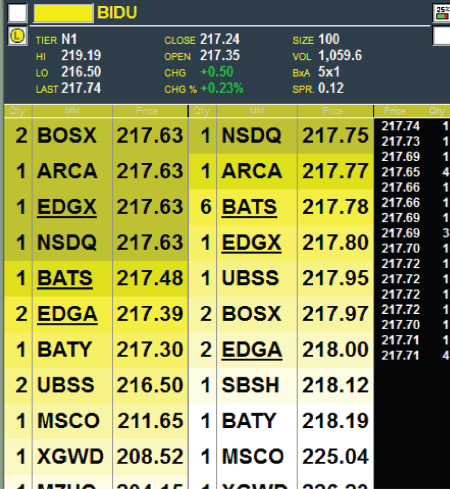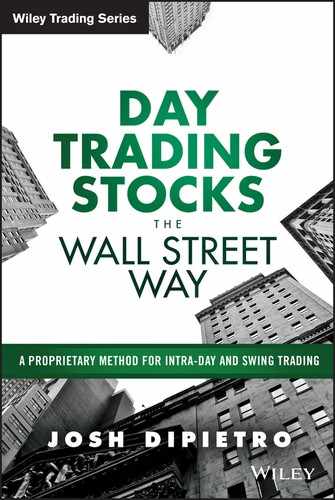Lesson 14
Picking the Right Online Broker
Pay-per-Share versus Pay-per-Trade Brokers
There are pay-per-trade brokers and there are pay-per-share brokers. The main difference boils down to how much is your expense, or the commission you pay, per trade.
If you're a pro day trader, meaning you execute several roundtrip trades each day, then you need to have a low commission structure. I define low as paying between 40 cents and $1.00 per trade when trading in 100-share blocks.
Experience has shown me that most amateur day traders don't use pay-per-share brokers and they don't trade consistently in 100-share blocks. Much of the reason is that the traditional online brokerage industry, which is all about pay-per-trade brokers, maneuvers to retain amateur loyalty.
Here's a big secret that the pay-per-trade brokers don't want beginners to learn of. There are online brokers who charge as little as $.004 cents per share (pay-per-share). That amounts to about 40 cents per trade when trading in 100-share blocks. To the amateur who trades through a pay-per-trade broker and pays $5 to $10 per trade, no matter how many shares are purchased, to hear about that is a shocker—and good news. The few cents you read about above is no misprint.
“What's the catch?” amateurs ask me. “How come I never heard of pay-per-share online brokers?” And then they want to know: “Why only purchase 100 shares per trade?” Those are understandable questions. The answers may be surprising.
First, when you trade through a pay-per-share broker, there's no scam or catch at all. It's all about becoming more professional. If you plan on evolving to a “pattern day trader,” which means you plan to make several intra-day roundtrip trades, then you need a pay-per-share broker.
There is one condition that I suppose you could call a catch, but it's really a form of promotion: when you begin to advance as a day trader, which naturally involves pay-per-share, you'll find yourself becoming more and more regulated by the SEC. As I mentioned before, you need a minimum of 25K and the balance of your account cannot fall below that when intra-day trading stocks. If it does drop below that amount, you get hit with an “equity call.” That means that you can't trade on margin until you deposit enough funds to return your balance up to 25K.
If you're turned off by this financial requirement, then most likely you're not financially ready for professional day trading. Consider these facts: if you want to day trade for a living, then you need to make several intra-day trades without getting constantly hit in the wallet by those whopping pay-per-trade commissions. And you need at east 25K to make any real money.
I've mentioned that the pay-per-trade brokers maneuver to keep amateurs with them. One of the ways they do this is by pairing with popular training outfits that sign up huge groups of beginners. These day trading seminars and training programs usually don't tell you about pay-per-share firms, because they contract with pay-per-trade brokers. They sign you up and train you on their trading platforms during the training program. This enables such pay-per-trade brokers to profit off your trading activity. When I ponder that, the word racket comes to mind.
Also, pay-per-share firms don't advertise in primetime commercials. You only hear about them from experienced people like me. Because they seek only serious day traders, they prefer to keep a low profile.
Next question: Why just 100 shares per trade? The answer is simple: you're better safe than sorry. You're an amateur and you need to learn how to day trade in a cautiously low-risk environment. When trading in 100-share blocks, you're not going to overexpose yourself to market uncertainty.
Think about it. If you're trading 1,000 shares of a stock and it drops $2 intra-day, then you're in the red $2,000. Can you handle that kind of a scare? Can you handle that several times a day? If you only purchase 100 shares, however, then you're only potentially in the red by a measly $200. That's more psychologically manageable, especially for a beginner. Very few amateurs can stay consistently profitable when day trading in 1,000+ share blocks.
So how can amateurs start trading like the pros?
Most pro-traders' approach to day trading involves the following:
- Making many intra-day trades and swing trades
- Taking relatively small profits on each intra-day and swing trade
- Exiting losing trades quickly (at a predetermined price level), without emotion
- Minimizing commission costs
Most pro-traders place at least 50 trades per day (that's 25 roundtrip trades or more). They do both intra-day and swing trades. In that multiple-trade scenario, you don't need to purchase large share blocks. This is why most pro-traders find it safer and cheaper to place their trades in 100-share blocks, typically never accumulating more than 500 shares on a single position.
Another advantage to 100-share blocks is that orders get filled (buying and selling) much faster. Look at any Level 2 quote chart and you'll see all the streaming orders being placed. You'll note that most filled orders are between 100 and 500 shares at a time (as illustrated in the Level 2 quote chart in Figure L14.1).

Figure L14.1 Streaming Level 2 Quote Chart from Lightspeed Trading Platform
Taking small profits and small manageable losses is the key to remaining consistent all day. We pros look for quick 15-cent moves in the stock price on intra-day trades, so the pay-per-share commission structure is critical. Since most of the time we're trading in 100-share blocks, we chance to profit $15 on each trade. We normally don't stay in a trade over 15 minutes, and usually we're simultaneously trading at least three other stocks. So those small profits add up considerably.
There are several other features and benefits that pay-per-share trading firms offer. Other than low commission structures, the largest benefit to trading through pay-per-share brokers is direct access trading platforms. Direct access means that when you place a trade, it's not going through a middleman broker. You are purchasing directly from the market. You can purchase at the real ask price immediately. Also, direct access trading platforms offer FASTKEY order execution capabilities. This means you can use your keyboard buttons to execute orders. You will soon find out how awesome that is.
I always use a pay-per-share trading platform and commission structure. You will be using a demo trading platform during my program that has direct access Level 2 data feeds, meaning real-time demo trading.
“What if I only want to swing trade for $1.50 to $2.00 profits?” You can keep you current pay-per-trade broker and pay $9.99 per trade and still net decent profits. But why pay more in fees than you have to? And there are other factors to consider, such as the direct access of your current bid/ask prices. You will soon learn how important pre-market data is. Many brokers don't offer trading during pre-market.
